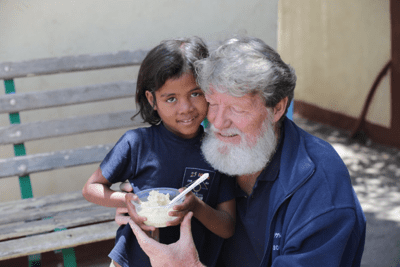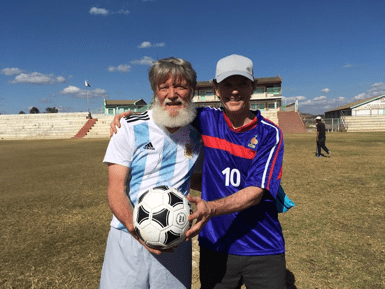Today we present the second part of the interview,which the Communications Office has held with the director and producer of the documentary “OPEKA”, Cam Cowen, which presents the life of the Vincentian missionary Father Pedro Opeka, CM, who has lived most of his life in Madagascar offering a new way of life to the poorest. He continues to share with us this beautiful missionary history, narrated from the film director’s point of view.
How much time did you spend with Father Opeka to figure out what you want to tell and how to do it in your documentary?
I knew quickly what I wanted to tell in the film. Recently I was asked to describe Father Pedro. My response was: “Powerful. Fearless. Brilliant.  Genuine.” I wanted those qualities to be revealed. I also wanted to focus on him as a humanitarian who emphasizes education, hard work, health and dignity, and who is accomplishing something extraordinary for others at great sacrifice. He knows the political leaders of Madagascar have failed their people. He not only dares to speak truth to the political elite, he backs up his words and shows them by stunning example how to alleviate extreme poverty in their country.
Genuine.” I wanted those qualities to be revealed. I also wanted to focus on him as a humanitarian who emphasizes education, hard work, health and dignity, and who is accomplishing something extraordinary for others at great sacrifice. He knows the political leaders of Madagascar have failed their people. He not only dares to speak truth to the political elite, he backs up his words and shows them by stunning example how to alleviate extreme poverty in their country.
Importantly, too, I wanted to present him as a complete person and try to avoid indulging in hero worshipping. If there were warts, I wanted them revealed. If there were opinions he had that might ruffle feathers, I wanted them heard. He is not a superhero doing an ordinary superhero thing. He is a human being doing something truly extraordinary, and I wanted his story to inspire us all to try – just try – to help others in a meaningful way.
All of these considerations led me to the title, “OPEKA”. I didn’t want “Father Pedro” with a tag line about being a friend of the poor, or something like that. I wanted the title to be as powerful as he is and to capture the full measure of the man. A tag line can’t do that. “OPEKA” does, I believe.
How to tell the story took much more time. Much more. In a profile film such as this, often the director will rely on people who know the subject to tell much of his/her story. I wanted to do something different. I wanted the viewer to be with Father Pedro on his 50-year journey in Madagascar, and even further back to his youth in Buenos Aires. After months of collecting verité and finding archival footage, I decided the best way to be with Father Pedro on his extraordinary journey was for him to be the narrator of that journey.
And so, after he put up significance resistance, I persuaded him to let me interview him on camera to capture his full story, from his parents’ lives in post-war Slovenia to the present. We spent weeks interviewing him in his small study, in 3- and 4-hour sessions, and he truly disliked the experience. He hates talking about himself, preferring to expansively and emphatically talk about the children and poverty and politics, national and global. So, one of the things I am most proud of in our filming was being able to persuade him to keep on going with the interviews.
I also wanted to use a device of some kind that represented being with Father Pedro on this journey he narrates. And because we spent so much time with him while he drove us around Antananarivo talking, we realized during editing that driving in his truck would be the perfect “vehicle” for this. Our official poster for the film tries to capture the idea.
How did Father Opeka react when you asked him if you can make a documentary focused on his experience in Madagascar?
He resisted at first. His life has been devoted to others, and he doesn’t like talking about himself and certainly doesn’t like talking about his private thoughts and experiences. But I believe I was able to persuade him that if we could make a quality film for a Western audience, reaching regions like North America where his work is less well known, it would be an opportunity to raise money for Akamasoa. I recall he eventually said, “If it could help the children, then I will do it.” Everything, always, to him is about helping the children.
Later, without Father Pedro’s knowledge, our production company – Sohei Productions – established a U.S. charitable organization dedicated to helping the children of Akamasoa: MadaKids.org. While “MADAGASIKARA” was in the 2018-19 film festival circuit, we were able to raise tens of thousands of dollars in the U.S. and send all of it to Akamasoa.
Now, with that film scheduled to be released to the public in late June, and with “OPEKA” in the 2020-21 film festival circuit, we are hoping to raise much more. There are similar organizations in many other countries that are dedicated to raising money for Akamasoa, and we hope this film will assist those efforts as well.
What were the most difficult moments of making the documentary and how did you overcome them?
 There were a few difficult moments. One, as I mentioned, was just persuading him to let us do the documentary. I had to tell him that ethically as a filmmaker I could not let him dictate what went into the film and what didn’t, that I had to make all of those decisions. I knew Father Pedro would have to take a leap of faith with me. It would be the first feature documentary of him distributed in North America, and it would probably be a film that would define his life’s story and his work creating Akamasoa. Fortunately, because of our time with Father Pedro during the filming of “MADAGASIKARA”, I believe – probably after a thorough risk /reward assessment – he decided to trust us.
There were a few difficult moments. One, as I mentioned, was just persuading him to let us do the documentary. I had to tell him that ethically as a filmmaker I could not let him dictate what went into the film and what didn’t, that I had to make all of those decisions. I knew Father Pedro would have to take a leap of faith with me. It would be the first feature documentary of him distributed in North America, and it would probably be a film that would define his life’s story and his work creating Akamasoa. Fortunately, because of our time with Father Pedro during the filming of “MADAGASIKARA”, I believe – probably after a thorough risk /reward assessment – he decided to trust us.
During filming, a difficult moment occurred in an open market area in Akamasoa. We were filming Father Pedro as he walked through the market talking with people, and suddenly he was accosted by a drunk woman. It was terribly unsettling to the crew, and the people in the market seemed to be getting out of control, but Father Pedro handled the conflict with compassion and restraint. That moment is captured in our film.
The most difficult moments, though, were witnessing what Father Pedro witnesses every day. It was hard for us to be walking with him through the city landfill next to Akamasoa, as the acrid smoke from burning garbage enveloped us and assaulted our senses. We observed people – families – mostly barefoot digging for clothing and bits of plastic and metal to sell.
It was also difficult to see the frequent funerals he officiated, particularly of the young. Father Pedro knows that his work is not yet done.
However, these difficult moments were overwhelmed by the joyful moments we experienced every day. Akamasoa is, in a way, an oasis in an impoverished land, and it was a privilege being a witness to the natural joy in the faces of the children there and the expectation they have for an educated and healthy life.

